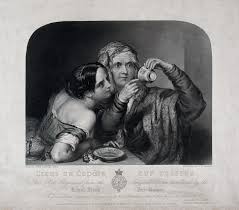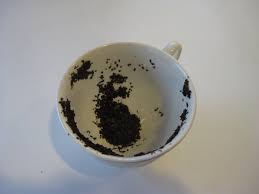<This post contains affiliate links so that the reader can easily locate the items mentioned in the article. Thank you>

The art of brewing, serving, and drinking tea has been part of human culture all over the world for ages. One of the oldest ones known to modern humans, the Chinese tea ceremony, dates back to the 8th century BC and has become an integral part of everyday Chinese life.
There’s more to tea culture than just enjoying a good cup of tea or looking for the best way to brew to get the ultimate taste. If you look a little deeper, you will be aware that there are metaphorical meanings, symbolism, and even mysticism behind every served cup of tea. So go ahead, take that deeper look and Tasseography will open your eyes and your mind to the possibilities!
One facet of tea culture that not many people are familiar with is Tasseography (also known as Tasseomancy or Tassology). It’s the art of reading tea leaves to gain insight into the unknown. Or so they say. But do people still practice it? How do you do it? What does science say about the practice? You’re about to find out!
A Brief History of Tasseography
The word tasseography is rooted from the Arabic word, tassa, which means cup, combined with the Greek suffix of graph (writing). So, tasseography can loosely be interpreted as the writing in the cup.
The variation of the word tasseology has logy ( the study of), and tasseomancy has mancy (divination) as the suffixes. The term is also applicable to the art of interpreting leftover coffee grounds or wine sediments.
The origin of tasseography can be traced back to medieval Europe where fortune tellers read splatters of wax, lead, and other molten substances in their divination. The method evolved into reading patterns of tea leaves after Dutch merchants introduced tea to Europe via trade routes to China.
Do People Today Still Practice Tasseography?
As a few hundred-year-old art of divination, tasseography (also known as tasseomancy) seems to have been lost in time. I’ll bet that many readers have just encountered the term for the first time while reading this article.
Those hoarse-voiced traveling gypsies or dark-hooded mysterious figures with crystal balls (I’m exaggerating here), who were known to practice the art, seem to have taken a permanent vacation from the modern human habitat.
In this era where we’ve hunted and captured (pocket) monsters using our mobile phones, practicing fortune telling using tea leaves at the bottom of the cup seems a bit absurd! But believe it or not, there are still those who dedicate their time and energy to tasseography.
You can easily find numerous sites on the web that discuss the topic and communities that share their wisdom with others who care to listen.
And although they fall into a very specific and precise niche, tasseography-related products such as cups, saucers, books, other accessories, and the tea itself, do have their loyal customers.
So we can safely assume that tasseography is certainly still alive and kickin’, even though it might be only at the level of a baby kick!
Tea Leaf Reading Meanings
Some of the people who tried tasseography claimed that tea leaf reading is fun and somewhat enlightening. I’m no expert in tasseography, so I go back to the good ol’ world wide web for references.
If you want to experience tasseography firsthand, out of curiosity, just for fun, or you want to dive in deeper, you can try the following steps. They should be easy enough, especially if you are a tea lover and want to discover the teal leaf reading meanings.
1. Prepare a cup of tea of your liking in a white or light colored teacup. Any tea should do the job just fine, but be sure not to use tea in the bag as there will be no tea leaf remains in the cup for you to read. You can take the tea out of the bag, or use raw tea leaves.
2. Let your tea cool for a little while you quiet your mind. Relax and prepare yourself for an exercise in creativity. You are going to try to find patterns and symbols. Be present. It’s as if you are preparing to start a meditation session.
3. Sip the tea when it’s cool enough and find your focus. You can try to focus on your breathing and count to ten on the exhale – ten on the inhale, and repeat. This process will help you calm the monkey in your brain who can’t stop making noises. If there’s one stubborn thought that keeps popping up, that might be the thing that you should focus on as the subject of the reading.
4. Pick up the cup using your non-dominant hand. But don’t drink everything up, leave a small amount of tea in the cup. Swirl the nearly empty cup three times and gently dump the remaining liquid. Use the saucer if you need help draining the cup. Then wait for at least three breathing cycles before starting the reading.
5. Identify the pattern and symbols at the bottom of the cup and jot them down. Begin your reading from the cup handle and continue clockwise to identify the patterns and symbols along the way. Also, make note of the location, is it in the rim, middle, or the bottom of the cup. Write down anything that comes into your mind, including bubbles, twigs, droplets, etc. Don’t rush things, concentrate and take your time. If the cup has no handle, start from the 12 o’clock position.
6. Interpret the reading using your own understanding. For example, if you see a butterfly, and you know too well how much your best friend loved butterflies, it might be something related to your best friend. Write down what each symbol means to you. It should be the pure thought that first comes to your mind. Thinking too hard will only ruin it! Try not to contaminate it with something that you want or need.
Please note that there are also those who don’t bother to drink the tea. The tea just gets dumped, and then they go straight to the reading part. It’s possible that they have repeated the process so many times that the thought of drinking another cup of tea is just too much for them, or it’s also possible that they have other reasons for doing so. Whatever the reason is, the rules aren’t set in stone. Who am I to say which one is right and which one is wrong?
Here are few additional notes about the reading:
- Pay close attention to the first pattern or symbol that you see. It represents your dominant character, someone near, or someone influential.
- The rim represents this moment in time while the middle section is the near future. Both areas contain influences as to the outcome.
- Everything in the base of the cup represents the ultimate answer or conclusion.
- The result of each reading is very personal, and the person who can best interpret the result is the one who is doing the reading. That being said, there are many common symbols with universal meanings, and having them as a reference might help you to understand your reading better.
If you’ve been taking everything that you read so far with a pinch of salt, while considering it to be a fun mumbo-jumbo mysticism, then maybe it’s the perfect time to let some science kick in!
Wait. What?
I also had my doubts as to whether there’s any scientific explanation to the ancient art of telling the future by reading tea leaves scattered randomly inside a teacup. But please bear with me for a while.
Various references consider tea leaf reading as an abstract pattern recognition. It’s somewhat similar to Rorschach (Ink Blot) Test where the subject is asked to identify images of abstract ink splatter. Rorschach (Ink Blot)
Rorschach (Ink Blot)
This kind of test is commonly used in modern psychology to access the subconscious state of an individual, something that the person already knows but keeps buried deep inside.
That’s why tasseography is a very personal and subjective endeavor. It’s your self-analysis that produces the most relevant reading. What you see in the patterns might be different from what the person next to you perceives. You should do your reading, and the “expert” – if you are lucky enough to have one present during the reading – should act as the guide and not the main cast of the show.
Why All the Ceremonials?
But if it’s “only” the act of abstract pattern recognition, what is with those “use non-dominant hand” or “swirl three times” or “read in clockwise direction” thingy? Why all the ceremonials if you can just splatter all the tea leaves on the table and do the reading there? It’s more practical, takes less time, and is also as random as it could be anyway.
Well, I can’t find any reference to that, but if I may share my two cents here, it might be a guided conditioning to go into the meditative state. In this state, the subconscious is more present, and you can produce a more accurate reading. It might be something similar to chanting during religious ceremonies or chiming the bell during Buddhist prayers.
Would You Try Tasseography?

While the goal of this rather long article is not to persuade anyone to practice tasseography, there’s nothing wrong in trying it every once in a while. It would be a fun, interesting, and relaxing activity for a tea party, regardless of the accuracy.
It could also be used as a way to try meditation – either individually or in a group. The Japanese are known to use tea ceremonies as a form of meditation.
And the most important reason for the tea lovers among us, you can use tasseography as an excuse to enjoy more tea!
SO…WHAT DID YOU THINK? DID YOU ENJOY THIS ARTICLE? WANT TO LEARN A LITTLE MORE ABOUT TEA LEAF READING MEANINGS
AND HAVE SOME FUN?
DISCOVER WHAT IT’S LIKE TO BE A MODERN DAY TEA LEAF READER WITH THESE TEA LEAF FORTUNE CARDS!


HI – I personally have never heard the word ‘Tasseography’, although I’ve read, mainly in fictional books, about reading tea leaves. I come from Ireland, where there are still some older folk who read your tea cup. Beyond that, I didn’t know it existed outside of Harry Potter!
I will definitely be trying it! Thank you!
Hi Dawn, you’re definitely not alone as far as connecting it to Harry Potter. Lol. But do try and give it a go! It’s lots of fun 🙂
Hi there! How interesting! First thing I thought of was Harry Potter, too. I loved the Professor Trelawny character in the movies. 🙂 It makes sense to compare it to the Rohrschach test. I might just have to give it a try, just for fun.
Hi Marge, I agree with you. Emma Thompson was perfection in her role as Professor Trelawny. Let me know how it goes when you try it out!
I’m of Armenian descent and my ancestors were known for their tea leaf readings. I remember my grandmother reading tea leaves for family, friends and neighbors every Saturday night. What a time it was! It was also a time to drink tea and gossip. Haha.
Thanks for the nostalgia!
How much fun those Saturday nights must have been, Walda. You can bet that had I been family, friend, or neighbor, I would have never missed one of those get-togethers! Glad to have provided a little bit of nostalgia for you. Thanks for sharing.
Very interesting! I come from Middle Eastern descent and have observed reading of leftover coffee grounds by people in my parent’s generation. I didn’t know what it was called or anything about its history. Thanks for the article!
Hi George. I love learning about new things and it makes me so happy whenever I’ve shared something that is new to others! Thanks for reading my article and I’m glad you enjoyed it 🙂
This is very interesting. I’ve been thinking of getting into Tarot recently as a friend’s partner is a reader. But this is the first I’ve heard of Tasseography.
So I’m curious if the term Tasseography is only for tea, or is the general art or skill of reading various things, looking for signs, etc ?
Hi Nick 🙂 You’re not the only one. Most people haven’t heard of the word. It’s just not as common these days, even though it is still very much alive. Tasseography also refers to the telling of fortunes by reading coffee grounds and wine sediments as well. If you’re going to check into Tarot, why not a little tasseography too? Could be fun. And…if you just happen to be in New Orleans, Lousiana at any time, there’s a very old, very cool little shop that has been around since 1929 called “Bottom of the Cup Tea Room”. They still practice Tasseography as well as Tarot and I think you’d find it very interesting. There’s lots of other stuff going on in there too. This is the link in case you want to check it out: http://bottomofthecup.com/about.html